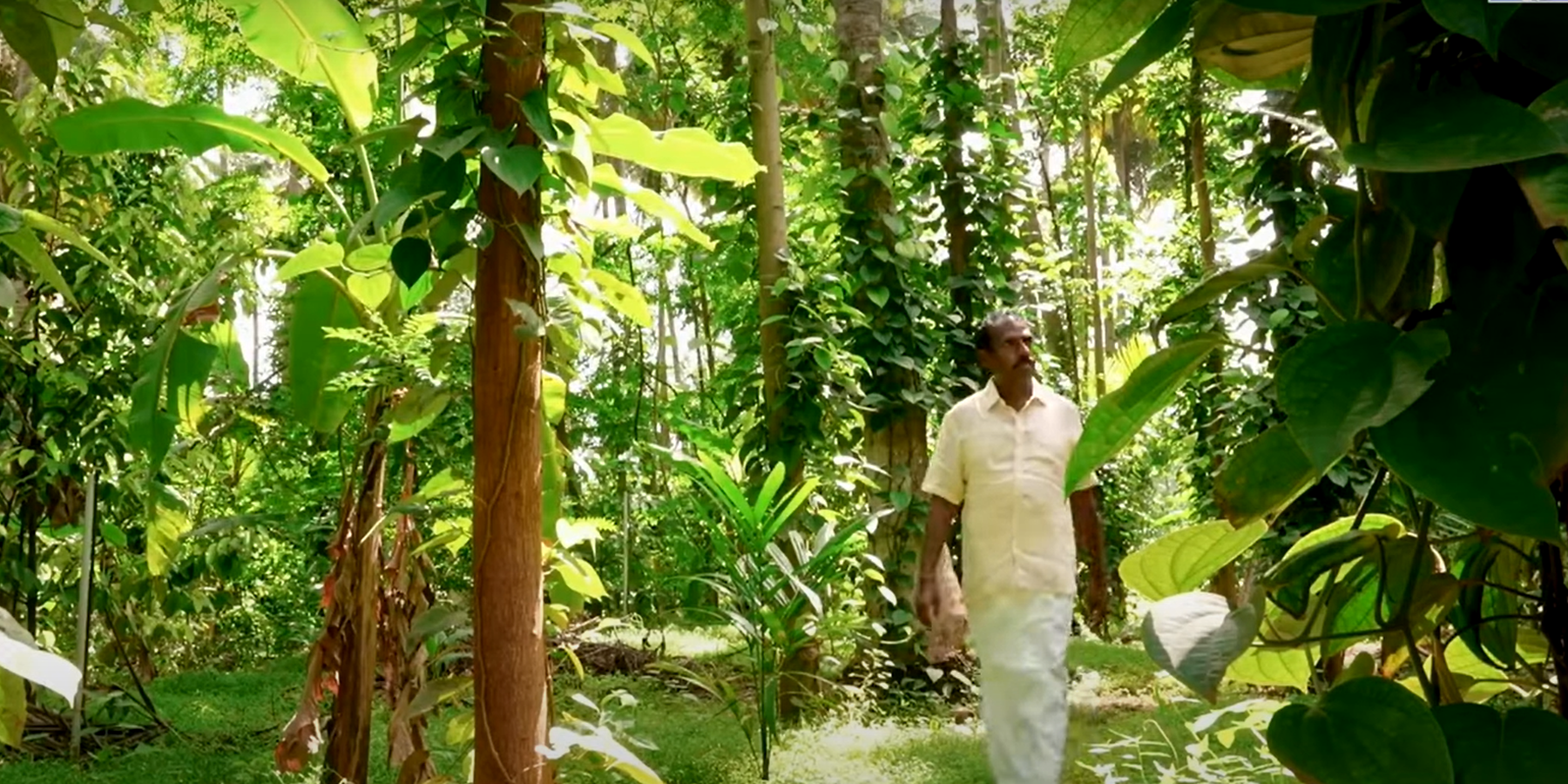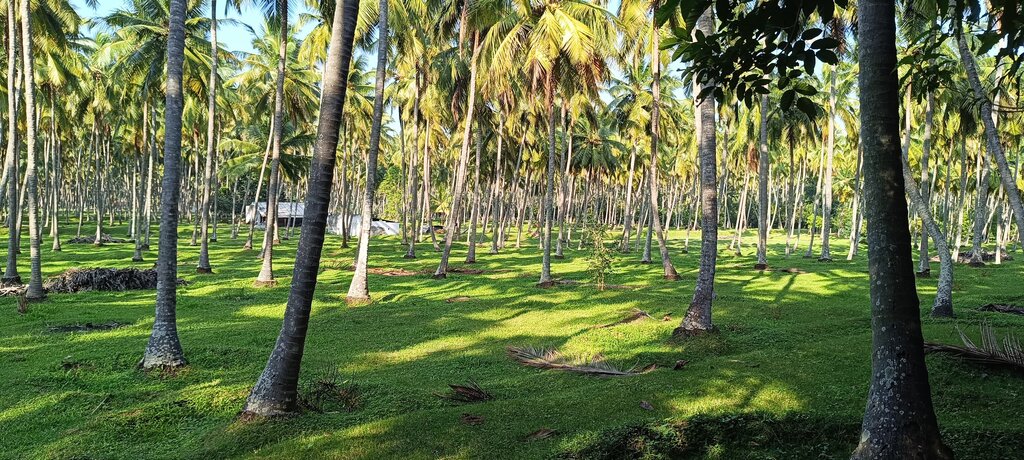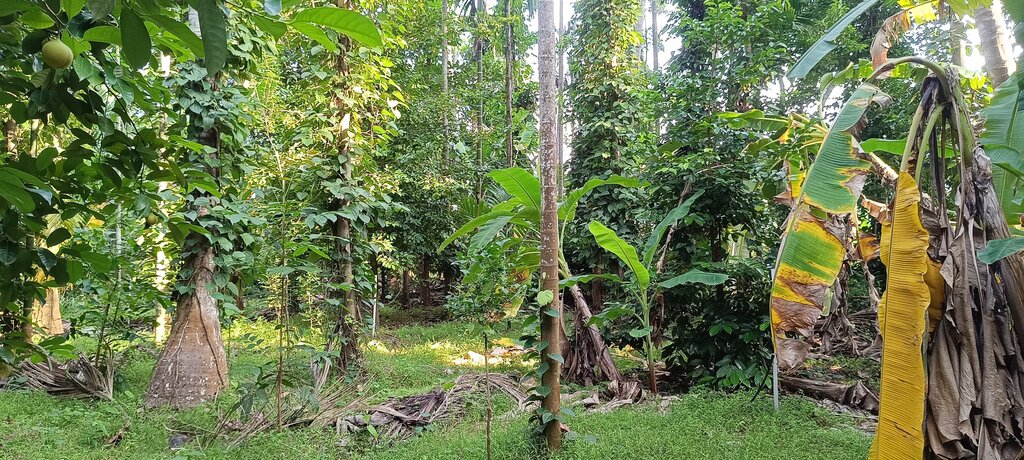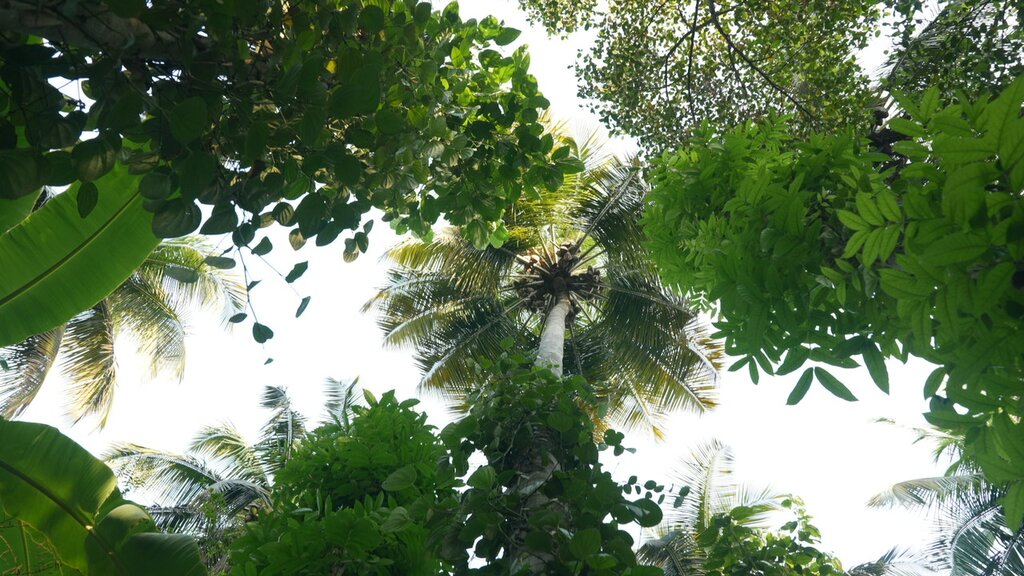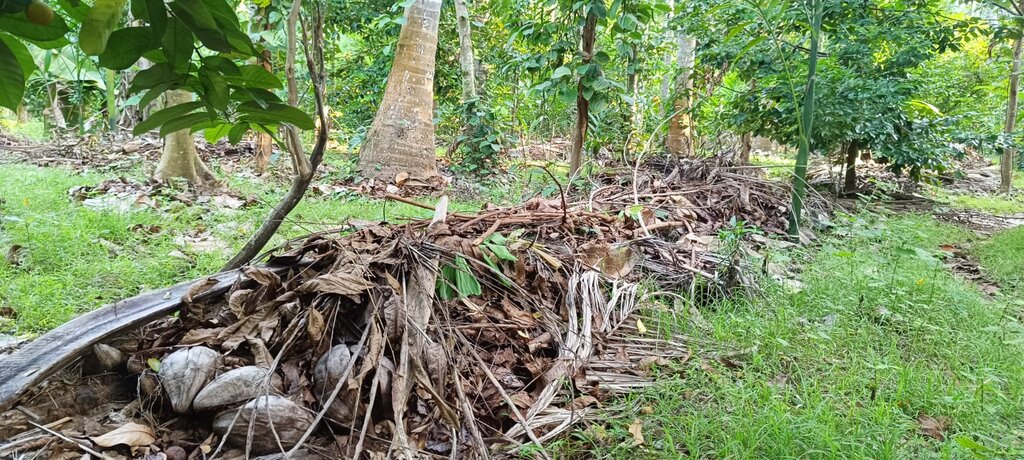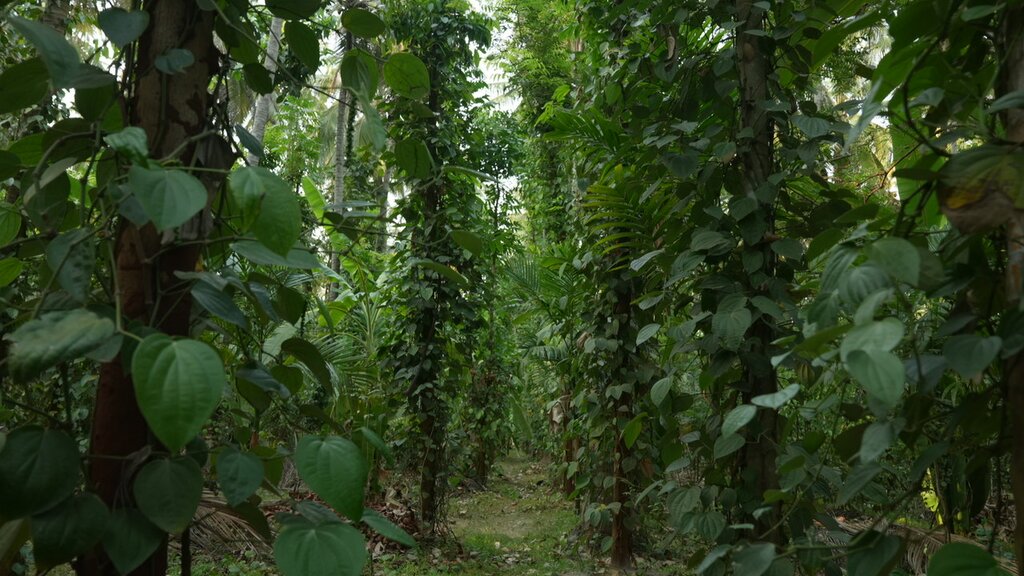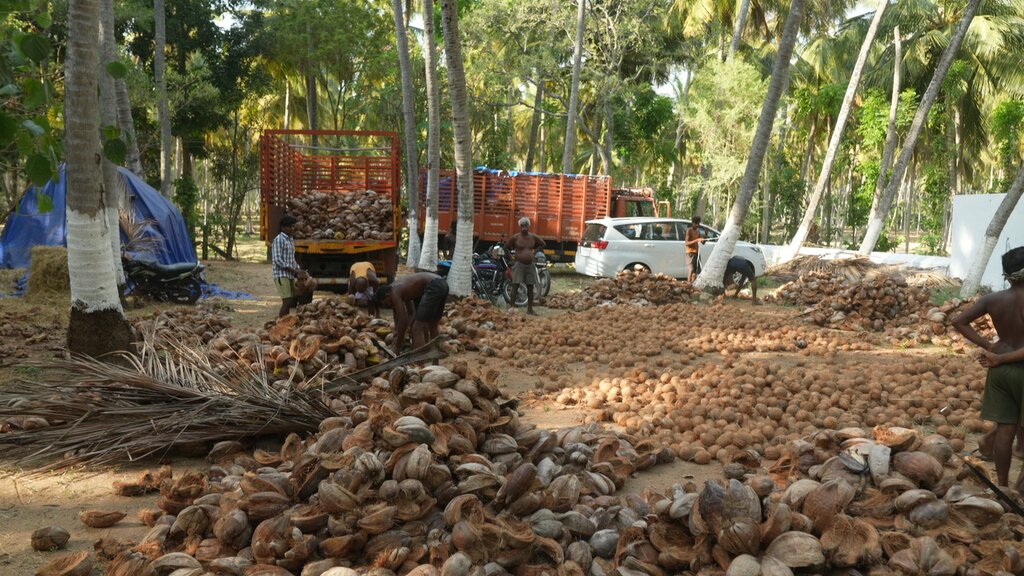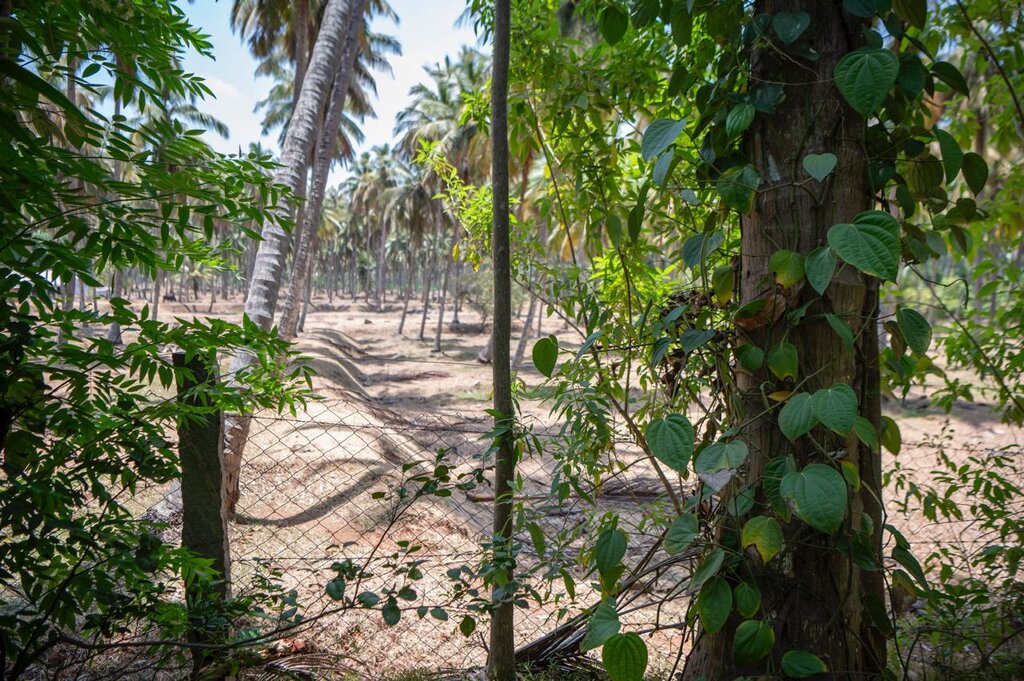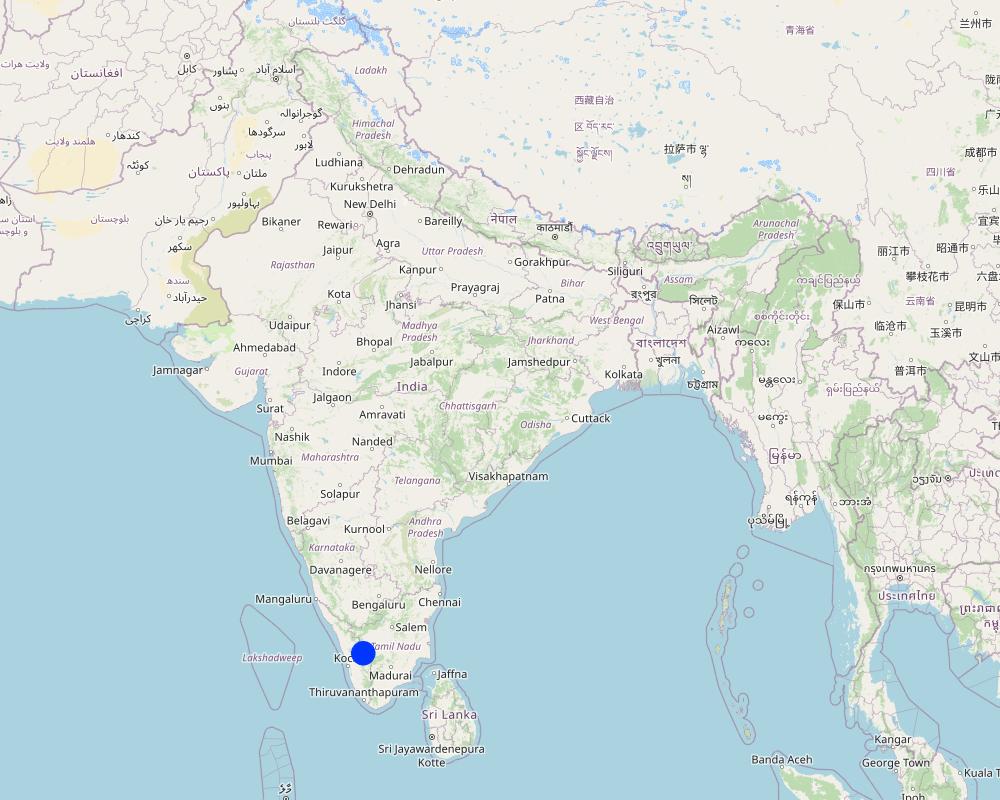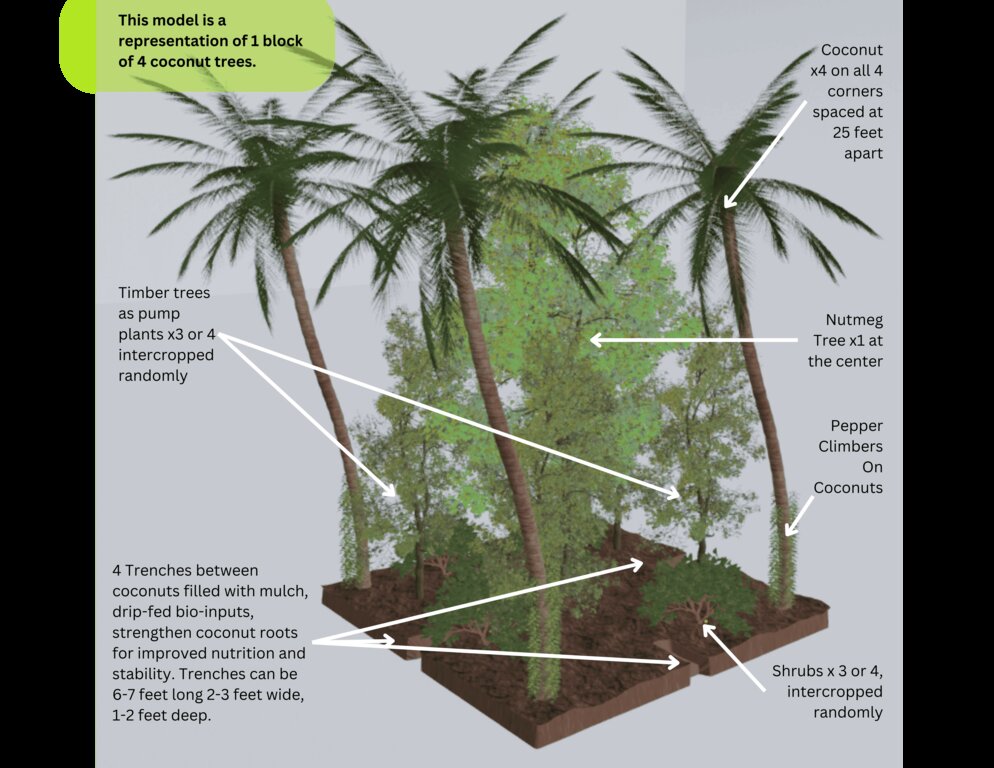Transforming a coconut monocrop into a multi-storey food forest [Índia]
- Criação:
- Atualização:
- Compilador/a: Praveena Sridhar
- Editores: Rushabh Desadla, Aditya Tated, Dhyana Balasubramanian, Vishwesh Singh, Lu Yu
- Revisores: William Critchley, Joana Eichenberger
Ottraipayir Thennai Sagubadi Muraiyai Pala Adukku Unavu Kaadaga Matruthal.
technologies_7366 - Índia
Veja as seções
Expandir tudo Recolher tudo1. Informação geral
1.2 Detalhes do contato das pessoas capacitadas e instituições envolvidas na avaliação e documentação da tecnologia
Especialista em GST:
Especialista em GST:
Nome do projeto que facilitou a documentação/avaliação da Tecnologia (se relevante)
Save Soil MovementNome da(s) instituição(ões) que facilitou(ram) a documentação/ avaliação da Tecnologia (se relevante)
Conscious Planet - Save Soil (Save Soil)1.3 Condições em relação ao uso da informação documentada através de WOCAT
O/a compilador/a e a(s) pessoa(s) capacitada(s) aceitam as condições relativas ao uso de dados documentados através da WOCAT:
Sim
1.4 Declaração de sustentabilidade da tecnologia descrita
A tecnologia descrita aqui é problemática em relação a degradação da terra de forma que não pode ser declarada uma tecnologia de gestão sustentável de terra?
Não
1.5 Referência ao(s) questionário(s) sobre abordagens GST (documentado(s) usando WOCAT)
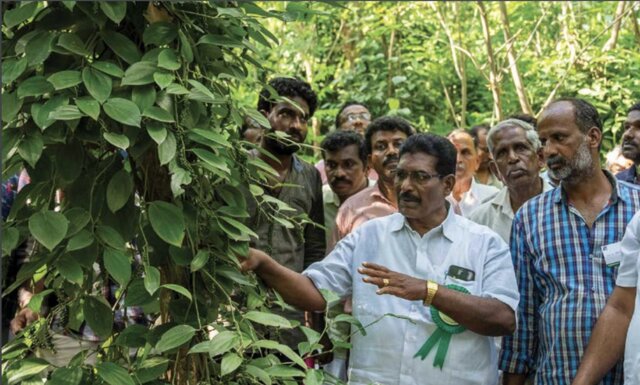
Conscious Planet - Save Soil’s Farmer Training and … [Índia]
The approach focuses on supporting farmers to increase productivity by increasing soil biology and organic matter content, primarily through plant residue and animal waste. Awareness and advocacy are followed by training programs and support for adopting regenerative agricultural practices.
- Compilador/a: Praveena Sridhar
2. Descrição da tecnologia de GST
2.1 Descrição curta da tecnologia
Definição da tecnologia:
Transforming a monocrop coconut farm into a resilient food forest can sustainably enhance soil health, biodiversity and productivity while reducing labour and external input requirements. This demonstrates the potential to increase yields and provide long-term economic and ecological stability for farmers.
2.2 Descrição detalhada da tecnologia
Descrição:
Transforming a monocrop coconut farm into a resilient food forest can sustainably enhance soil health, biodiversity, and productivity while reducing labour and external input requirements. This demonstrates the potential to increase yields and provide long-term economic and ecological stability for farmers. Experience was gained from implementation in 2008 on a monocrop coconut farm in Pollachi, Tamil Nadu. The stages were as follows:
1) Rainwater management: Trenches were dug throughout the farm to retain rainwater and prevent runoff, thus enhancing soil moisture. This was critical given the limited rainfall in the region. A drip irrigation system was installed for efficient watering.
2) Plant diversity: Various crops were introduced. Nutmeg, intercropped among coconut trees, provides 3 - 4 times the income of coconuts after 15 to 20 years. Timber trees extract micronutrients from deeper soil layers via deep tap roots: micronutrients are concentrated in the leaves which are used as mulch to enrich the soil nutrient profile. Banana and papaya provided early income, shade for plants, and added biomass. This diversity also ensures a steady income, reducing dependency on external markets.
3) Biomass and soil fertility improvement: Fast-growing crops were planted to generate additional biomass. Leaves were pruned and added to the water-retaining trenches as mulch. Nitrogen-fixing plants were cultivated extensively to improve soil fertility, eliminating the need for chemical fertilizers.
4) Mulch and bio-input application: Mulch in the trenches was decomposed by the bio-inputs from Cows (Earlier 2, now 1) applied via drip lines, which increased soil organic matter through enhanced microbial decomposition. The irrigation and sprinklers were used judiciously to achieve soil moisture rather than over-watering, as trees primarily needed stable moisture conditions.
5) Minimal maintenance approach: After establishing this system, the farm required minimal maintenance. There was no need for tilling, weeding, or other intensive practices, just monitoring of, and maintaining, moisture levels. This low-maintenance approach reduces farmers’ workloads and improves their quality of life.
6) Enhanced biodiversity and pest management: To further enhance biodiversity, flowering plants to attract pollinators and predatory insects can be planted along the farm's boundaries - though this was not done at this particular site. Nonetheless, the increased biodiversity already fostered here brought in earthworms, birds, and beneficial insects for natural pest management.
After 12 years of minimal maintenance, soil organic matter content increased from 0.5% to 3.36%, and both production quantity and quality increased. The farm retained high soil moisture despite periods of low rainfall. Land users liked the use of minimal inputs, crop diversification as a financial safety net, and the visible impact on soil health and yield, as well as the increase in land value. There was initial fear about time and money invested and doubts about the feasibility of a technology that challenged the status quo of the region. Digging trenches and planting saplings were physically demanding. The initial pest pressure was also a concern before a stable ecosystem was established. The transformation of this coconut monoculture into a diverse food forest has demonstrated a sustainable model of enhanced resilience, productivity, and biodiversity. This model can be replicated across similar regions to help minimize labor and improve farmers’ livelihoods while restoring land and ecosystems.
2.3 Fotos da tecnologia
2.4 Vídeos da tecnologia
Comentários, breve descrição:
With a few simple interventions, soil that was infertile was brought back to life.
YouTube video link: https://youtu.be/Pt4AEXzgTfc?feature=shared
Data:
10/06/2022
Localização:
Pollachi, Tamil Nadu
Nome do cinegrafista:
Save Soil Media team
2.5 País/região/locais onde a tecnologia foi aplicada e que estão cobertos nesta avaliação
País:
Índia
Região/Estado/Província:
Tamil Nadu
Especificação adicional de localização:
Pollachi
Especifique a difusão da tecnologia:
- Aplicado em pontos específicos/concentrado numa pequena área
O(s) local(is) tecnológico(s) está(ão) localizado(s) em uma área permanentemente protegida?
Não
Map
×2.6 Data da implementação
Caso o ano exato seja desconhecido, indique a data aproximada:
- 10-50 anos atrás
2.7 Introdução da tecnologia
Especifique como a tecnologia foi introduzida:
- através de projetos/intervenções externas
Comentários (tipos de projeto, etc.):
The key contributions to the project's technical knowledge include Ethirajalu R (Technical Expert), Anand Ethirajal (Operations Lead), and Dr. Poonyamurti (Ethnoveterinary Medicines Expert). Their expertise, along with the valuable insights shared by Indian stalwarts like Nammalwar, Sripad Davolkar, and Subhash Palekar
3. Classificação da tecnologia de GST
3.1 Principal/principais finalidade(s) da tecnologia
- Melhora a produção
- Reduz, previne, recupera a degradação do solo
- Preservar/melhorar a biodiversidade
- Atenuar a mudanças climáticas e seus impactos
- Criar impacto econômico benéfico
3.2 Tipo(s) atualizado(s) de uso da terra onde a tecnologia foi aplicada
Uso do solo misturado dentro da mesma unidade de terra:
Sim
Especificar o uso misto da terra (culturas/ pastoreio/ árvores):
- Agrofloresta

Terra de cultivo
- Cultura perene (não lenhosa)
- Cultura de árvores e arbustos
- Climbers : Pepper
Cultivo perene (sem lã) - Especificar culturas:
- banana/planta/abacá
- plantas medicinais, aromáticas, agrotóxicas - perenes
- Curry Leaves, Lime, Turmeric, Papaya
Cultivo de árvores e arbustos - Especificar culturas:
- coco (frutas, coco, folhas, etc.)
- Nutmeg, Mahogany, Mountain Neem, Kino, Red Sandalwood, Blackwood, White Teak, Iron Wood
Número de estações de cultivo por ano:
- 1
O cultivo entre culturas é praticado?
Sim
O rodízio de culturas é praticado?
Não
3.3 O uso do solo mudou devido à implementação da Tecnologia?
O uso do solo mudou devido à implementação da Tecnologia?
- Sim (Por favor, preencha as perguntas abaixo com relação ao uso do solo antes da implementação da Tecnologia)
Uso do solo misturado dentro da mesma unidade de terra:
Não

Terra de cultivo
- Cultura de árvores e arbustos
Cultivo de árvores e arbustos - Especificar culturas:
- coco (frutas, coco, folhas, etc.)
O cultivo entre culturas é praticado?
Não
O rodízio de culturas é praticado?
Não
3.4 Abastecimento de água
Abastecimento de água para a terra na qual a tecnologia é aplicada:
- Misto de precipitação natural-irrigado
3.5 Grupo de GST ao qual pertence a tecnologia
- Agrofloresta
- Solo/cobertura vegetal melhorada
- Gestão integrada de fertilidade do solo
3.6 Medidas de GST contendo a tecnologia

Medidas agronômicas
- A1: cobertura vegetal/do solo
- A2: Matéria orgânica/fertilidade do solo
- A6: Gerenciamento de resíduos
A6: Especificar o gerenciamento de resíduos:
A 6.4: retido

Medidas vegetativas
- V1: cobertura de árvores/arbustos

Medidas estruturais
- S2: Barragens, bancos
- S4: Valas de nível, fossos
- S6: Muros, barreiras, paliçadas, cercas
- S7: coleta de água/ equipamento de abastecimento/irrigação
- S8: Saneamento/estruturas de águas residuais
- S9: Abrigo para plantas e animais
3.7 Principais tipos de degradação da terra abordados pela tecnologia

Erosão do solo pela água
- Wt: Perda do solo superficial/erosão de superfície

Erosão do solo pelo vento
- Et: Perda do solo superficial

Deteriorização química do solo
- Cn: declínio de fertilidade e teor reduzido de matéria orgânica (não causado pela erosão)
- Ca: acidificação
- Cp: poluição do solo
- Cs: salinização/alcalinização

Deteriorização física do solo
- Pc: Compactação

Degradação biológica
- Bc: redução da cobertura vegetal
- Bh: perda dos habitats
- Bq: quantidade/ declínio da biomassa
- Bs: Qualidade e composição de espécies/declínio de diversidade
- Bl: perda da vida do solo
- Bp: aumento de pragas/doenças, perda de predadores

Degradação da água
- Ha: aridificação
- Hs: mudança na quantidade de água de superfície
- Hg: mudança no lençol freático/aquífero
- Hq: declínio da qualidade do lençol freático
3.8 Redução, prevenção ou recuperação da degradação do solo
Especifique o objetivo da tecnologia em relação a degradação da terra:
- Recuperar/reabilitar solo severamente degradado
4. Especificações técnicas, implementação de atividades, entradas e custos
4.1 Desenho técnico da tecnologia
Especificações técnicas (relacionada ao desenho técnico):
Area: 25 x 25 square feet.
Number of Coconut Trees: 4
Number of Nutmeg Trees: 1
Number of Pepper Climbers: 4
Number of Shrubs: 3-4 (Lime, Curry leaves, Medicinal herbs and Turmeric)
Number of Timber Trees : 3-4 (Mahogany, Mountain Neem, Kino, Red Sandalwood, Blackwood, White Teak and Ironwood)
Number of trenches : 4 ( 6x3x2 ft each, half in this block, half extended to the next block.
Irrigation System: Drip and a Center Fog Sprinkler for creating moisture in the atmosphere.
Input application: Cow dung and Cow urine mix flows to the trench covered with biomass. Decomposes it over time and creates humus for all the plants.
Initially biomass crops are planted, slowly transitioning to trees as the soil improves.
No maintenance after 3-4 years.
Coconut collected after it drops naturally.
Nutmeg and Pepper harvest happens in 3-4 years, gradually increasing yields.
Shrubs are harvested occasionally for self consumption and direct on farm sales.
Autor:
Aditya Tated
Data:
29/10/2024
4.2 Informação geral em relação ao cálculo de entradas e custos
Especifique como custos e entradas foram calculados:
- por área de tecnologia
Indique o tamanho e a unidade de área:
5.66 hectares
Se utilizar uma unidade de área local, indicar fator de conversão para um hectare (por exemplo, 1 ha = 2,47 acres): 1 ha =:
1hectare = 2.47 acres
Outro/moeda nacional (especifique):
INR
Se for relevante, indique a taxa de câmbio do USD para moeda local (por exemplo, 1 USD = 79,9 Real): 1 USD =:
84,07
Indique a média salarial da mão-de-obra contratada por dia:
600 INR
4.3 Atividades de implantação
| Atividade | Periodicidade (estação do ano) | |
|---|---|---|
| 1. | Plot assessment and planning | Before onset of rains |
| 2. | Digging trenches for rainwater harvesting | Before the rainy season |
| 3. | Setting up drip irrigation system | Before planting; dry season |
| 4. | Planting initial tree species (timber, fruit, nitrogen-fixing) | Early rainy season |
| 5. | Planting startup crops (e.g., banana, papaya) | Early rainy season |
| 6. | Mulching trenches with plant biomass | After trench creation, ongoing |
| 7. | Adding bio-inputs to mulch beds | Throughout growing seasons |
| 8. | Pruning trees and returning biomass | Regular intervals during dry seasons |
| 9. | Planting additional companion species | After initial species establishment |
| 10. | Setting up pest repellent measures | As needed, ongoing |
4.4 Custos e entradas necessárias para a implantação
| Especifique a entrada | Unidade | Quantidade | Custos por unidade | Custos totais por entrada | % dos custos arcados pelos usuários da terra | |
|---|---|---|---|---|---|---|
| Mão-de-obra | Trench Digging | machine-hours | 100,0 | 1000,0 | 100000,0 | 100,0 |
| Mão-de-obra | Tree Planting | person-days | 75,0 | 600,0 | 45000,0 | 100,0 |
| Equipamento | Farm Tools | lump sum | 1,0 | 20000,0 | 20000,0 | 100,0 |
| Equipamento | Irrigation Setup | lump sum | 1,0 | 100000,0 | 100000,0 | 100,0 |
| Equipamento | Pruning Machine | units | 1,0 | 25000,0 | 25000,0 | 100,0 |
| Material vegetal | Timber Saplings | units | 5500,0 | 3,0 | 16500,0 | 100,0 |
| Material vegetal | Nutmeg Saplings | units | 1000,0 | 20,0 | 20000,0 | 100,0 |
| Material vegetal | Pepper Saplings | units | 1000,0 | 40,0 | 40000,0 | 100,0 |
| Material vegetal | Fruit Trees | units | 500,0 | 100,0 | 50000,0 | 100,0 |
| Fertilizantes e biocidas | Organic Manure | load | 10,0 | 1500,0 | 15000,0 | 100,0 |
| Fertilizantes e biocidas | Organic Pest Repellants | lump sum | 1,0 | 20000,0 | 20000,0 | 100,0 |
| Material de construção | Fencing Irrigation | lump sum | 1,0 | 200000,0 | 200000,0 | 100,0 |
| Material de construção | Bio-Input Preparation Unit | lump sum | 1,0 | 200000,0 | 200000,0 | 100,0 |
| Material de construção | Pipes and Valves | lump sum | 1,0 | 530000,0 | 530000,0 | 100,0 |
| Material de construção | Tool Shed | lump sum | 1,0 | 50000,0 | 50000,0 | 100,0 |
| Material de construção | Worker Shed | lump sum | 1,0 | 50000,0 | 50000,0 | 100,0 |
| Outros | Farm Animals | units | 5,0 | 20000,0 | 100000,0 | 100,0 |
| Outros | Fodder | annual | 1,0 | 25000,0 | 25000,0 | 100,0 |
| Custos totais para a implantação da tecnologia | 1606500,0 | |||||
| Custos totais para o estabelecimento da Tecnologia em USD | 19109,08 | |||||
Comentários:
Land user bore all costs
4.5 Atividades recorrentes/manutenção
| Atividade | Periodicidade/frequência | |
|---|---|---|
| 1. | Pruning | Every 6 months |
| 2. | Irrigation system maintenance | Annually, before dry season |
| 3. | Mulching trenches | Twice a year, before onset of rains |
| 4. | Adding bio-inputs to mulch beds | Happens automatically with irrigation. |
| 5. | Harvesting fruits and biomass | As and when needed Coconut is collected after it falls by itself. |
| 6. | Replanting missing or damaged trees | Annually, before rainy season |
| 7. | Fencing and protection checks | Quarterly |
4.6 Custos e entradas necessárias pata a manutenção/atividades recorrentes (por ano)
| Especifique a entrada | Unidade | Quantidade | Custos por unidade | Custos totais por entrada | % dos custos arcados pelos usuários da terra | |
|---|---|---|---|---|---|---|
| Mão-de-obra | Pruning, mulching, replanting | person-days | 100,0 | 600,0 | 60000,0 | 100,0 |
| Mão-de-obra | Harvesting | person-days | 300,0 | 600,0 | 180000,0 | 100,0 |
| Equipamento | Tools for pruning fencing checks | lump sum | 1,0 | 10000,0 | 10000,0 | 100,0 |
| Equipamento | Irrigation system maintenance | lump sum | 1,0 | 10000,0 | 10000,0 | 100,0 |
| Equipamento | Fencing maintenance | lump sum | 1,0 | 20000,0 | 20000,0 | 100,0 |
| Material vegetal | Replacement seedlings | pieces | 50,0 | 30,0 | 1500,0 | 100,0 |
| Fertilizantes e biocidas | Preparing organic bio-inputs via irrigation system | lump sum | 1,0 | 5000,0 | 5000,0 | 100,0 |
| Material de construção | Fencing materials for repair | lump sum | 1,0 | 8000,0 | 8000,0 | 100,0 |
| Outros | Cow Care and Fodder | kg | 5,0 | 5000,0 | 25000,0 | 100,0 |
| Custos totais para a manutenção da tecnologia | 319500,0 | |||||
| Custos totais de manutenção da Tecnologia em USD | 3800,4 | |||||
Comentários:
Land users bore all costs
4.7 Fatores mais importantes que afetam os custos
Descreva os fatores mais determinantes que afetam os custos:
No factors significantly affected costs.
5. Ambiente natural e humano
5.1 Clima
Precipitação pluviométrica anual
- <250 mm
- 251-500 mm
- 501-750 mm
- 751-1.000 mm
- 1.001-1.500 mm
- 1.501-2.000 mm
- 2.001-3.000 mm
- 3.001-4.000 mm
- > 4.000 mm
Especifique a média pluviométrica anual em mm (se conhecida):
865,00
Especificações/comentários sobre a pluviosidade:
Rainfall Distribution and Seasonality: Monsoon Seasons: Rainfall peaks during the southwest monsoon (June to September) and the northeast monsoon (October to November). August, October, and November are the rainiest months, each with an average precipitation between 167 to 214 mm.
Dry Periods: The driest months are January to March, with very low rainfall, averaging between 5 to 35 mm per month.
Indique o nome da estação meteorológica de referência considerada:
Coimbatore Metrological station, India Meteorological Department’s (IMD) network.
Zona agroclimática
- úmido
Generally warm, with an average annual temperature around 26–28°C (79–82°F). The hottest months tend to be March to May, where temperatures can reach up to 36–40°C (97–105°F), while the coolest months are December and January, with average daily temperatures ranging from 25–26°C (77–79°F)
5.2 Topografia
Declividade média:
- Plano (0-2%)
- Suave ondulado (3-5%)
- Ondulado (6-10%)
- Moderadamente ondulado (11-15%)
- Forte ondulado (16-30%)
- Montanhoso (31-60%)
- Escarpado (>60%)
Formas de relevo:
- Planalto/planície
- Cumes
- Encosta de serra
- Encosta de morro
- Sopés
- Fundos de vale
Zona de altitude:
- 0-100 m s.n.m.
- 101-500 m s.n.m.
- 501-1.000 m s.n.m.
- 1.001-1.500 m s.n.m.
- 1.501-2.000 m s.n.m.
- 2.001-2.500 m s.n.m.
- 2.501-3.000 m s.n.m.
- 3.001-4.000 m s.n.m.
- > 4.000 m s.n.m.
Indique se a tecnologia é aplicada especificamente em:
- Não relevante
5.3 Solos
Profundidade do solo em média:
- Muito raso (0-20 cm)
- Raso (21-50 cm)
- Moderadamente profundo (51-80 cm)
- Profundo (81-120 cm)
- Muito profundo (>120 cm)
Textura do solo (solo superficial):
- Fino/pesado (argila)
Textura do solo (>20 cm abaixo da superfície):
- Fino/pesado (argila)
Matéria orgânica do solo superficial:
- Baixo (<1%)
Caso disponível anexe a descrição completa do solo ou especifique as informações disponíveis, p. ex. tipo de solo, PH/acidez do solo, nitrogênio, capacidade de troca catiônica, salinidade, etc.
Soil type - Red sandy soil
5.4 Disponibilidade e qualidade de água
Lençol freático:
5-50 m
Disponibilidade de água de superfície:
Precário/nenhum
Qualidade da água (não tratada):
Água potável boa
A qualidade da água refere-se a:
águas subterrâneas
A salinidade da água é um problema?
Não
Ocorre inundação da área?
Não
Comentários e outras especificações sobre a qualidade e a quantidade da água:
Pollachi, the place where the farm is located, water quality fluctuates throughout the year, particularly due to agricultural runoff and effluents from nearby industrial activities.
5.5 Biodiversidade
Diversidade de espécies:
- Baixo
Diversidade de habitat:
- Baixo
5.6 Características dos usuários da terra que utilizam a tecnologia
Sedentário ou nômade:
- Sedentário
Orientação de mercado do sistema de produção:
- misto (subsistência/comercial)
Rendimento não agrícola:
- >50% de toda renda
Nível relativo de riqueza:
- Média
Indivíduos ou grupos:
- Indivíduo/unidade familiar
Nível de mecanização:
- Mecanizado/motorizado
Gênero:
- Mulheres
- Homens
Idade dos usuários da terra:
- meia-idade
5.7 Área média de terrenos utilizados pelos usuários de terrenos que aplicam a Tecnologia
- < 0,5 ha
- 0,5-1 ha
- 1-2 ha
- 2-5 ha
- 5-15 ha
- 15-50 ha
- 50-100 ha
- 100-500 ha
- 500-1.000 ha
- 1.000-10.000 ha
- > 10.000 ha
É considerado pequena, média ou grande escala (referente ao contexto local)?
- Média escala
5.8 Propriedade de terra, direitos de uso da terra e de uso da água
Propriedade da terra:
- Indivíduo, intitulado
Direitos do uso da terra:
- Indivíduo
Direitos do uso da água:
- Indivíduo
Os direitos de uso da terra são baseados em um sistema jurídico tradicional?
Sim
Especifique:
Private Ownership
5.9 Acesso a serviços e infraestrutura
Saúde:
- Pobre
- Moderado
- Bom
Educação:
- Pobre
- Moderado
- Bom
Assistência técnica:
- Pobre
- Moderado
- Bom
Emprego (p. ex. não agrícola):
- Pobre
- Moderado
- Bom
Mercados:
- Pobre
- Moderado
- Bom
Energia:
- Pobre
- Moderado
- Bom
Vias e transporte:
- Pobre
- Moderado
- Bom
Água potável e saneamento:
- Pobre
- Moderado
- Bom
Serviços financeiros:
- Pobre
- Moderado
- Bom
6. Impactos e declarações finais
6.1 Impactos no local mostrados pela tecnologia
Impactos socioeconômicos
Produção
Produção agrícola
Quantidade anterior à GST:
110
Quantidade posterior à GST:
160
Comentários/especificar:
Coconuts were small in size and fewer in number when the farm was bought. After 6-7 years, the counts increased from 110 per tree per year to 160 and size increased 150% on average.
Qualidade da safra
Quantidade anterior à GST:
Not so tasty
Quantidade posterior à GST:
Taste is the best compared to surrounding many farms.
Risco de falha de produção
Quantidade anterior à GST:
50-60%
Quantidade posterior à GST:
0%
Comentários/especificar:
The risk of production failure has come down to 0% as there is no pest and disease attack. The coconuts yield continuously throughout the year.
Diversidade de produtos
Quantidade anterior à GST:
1
Quantidade posterior à GST:
3
Comentários/especificar:
From just one crop to 2 main crops, pepper as a sub-main crop and a variety of fruits for self consumption.
Área de produção
Quantidade anterior à GST:
40%
Quantidade posterior à GST:
60%
Comentários/especificar:
Coconuts occupied approximately 40% area in terms of canopy. Now in addition to that there is nutmeg which occupies another 20%. Rest of the area is for timber and other supporting crops not included here.
Gestão de terra
Quantidade anterior à GST:
24/7
Quantidade posterior à GST:
1 Day a Week
Comentários/especificar:
Farmer before this owner spent hours in weeding, application of inputs and pesticide, burning of crop residue, harvesting coconuts. Now the whole farm needs 2 labour to collect fallen coconuts and turn on the irrigation switches and valves. The farmer comes to visit the farm once a week for monitoring.
Disponibilidade e qualidade de água
Qualidade da água potável
Disponibilidade de água para irrigação
Comentários/especificar:
Earlier the bore wells would run only for a couple of hours and then the water would dry out. Now it fulfills the irrigation requirement without interruption.
Demanda por água para irrigação
Comentários/especificar:
Demand for water has drastically come down as the SOC content in the soil has risen.
Renda e custos
Despesas com insumos agrícolas
Comentários/especificar:
There is no expense in any agricultural input apart from maintenance of 2-3 cows. The entire system is automatic. The slurry from the cowshed goes into the tank which supplies input through a venturi to the drip irrigaton system.
Rendimento agrícola
Comentários/especificar:
Farm income has gone up significantly owing to the high yields, multiple crops, better prices, low cultivation and management costs.
Diversidade de fontes de rendimento
Comentários/especificar:
Incomes are coming from sale of coconuts, nutmeg and pepper. Coconut oil is also extracted now by the farmer and sold at a high premium price.
Carga de trabalho
Comentários/especificar:
The drudgery of mainting a monocrop and all the works associalted with conventional agriculture is eliminated by 95%. The only workload is to pick up the fallen coconuts and harvest nutmeg and pepper.
Impactos socioculturais
Estado de saúde
Comentários/especificar:
The health of the owner and the consumers is greatly benefitted owing to the absense of harmful chemicals and pesticides in the produce.
Conhecimento de GST/ degradação da terra
Comentários/especificar:
This model is a great source of wisdom about tree-based regenerative agriculture which can counter land degradation. It has all the necessary components of how to convert dirt into soil.
Impactos ecológicos
Ciclo hídrico/escoamento
Qualidade de água
Colheita/recolhimento de água
Escoamento superficial
Drenagem de excesso de água
Lençol freático/aquífero
Evaporação
Solo
Umidade do solo
Comentários/especificar:
Soil moisture is maintained as high levels except for summers when its a little low due to the intense heat this region faces.
Cobertura do solo
Compactação do solo
Comentários/especificar:
Soil compaction has reduced because of the heavy penetraton of tree roots, improved SOC and biological activity in the soil.
Ciclo e recarga de nutrientes
Comentários/especificar:
It is evident from the yields that there is a very resilient process of nutrient cycling happening in the farm compared to what was happening earlier.
Matéria orgânica do solo/carbono abaixo do solo
Quantidade anterior à GST:
0.05
Quantidade posterior à GST:
3.36
Comentários/especificar:
The SOC level have increased continously and is still increasing because of the leaf litter that is added continuously throughout the year.
Biodiversidade: vegetação, animais
Cobertura vegetal
Quantidade anterior à GST:
40%
Quantidade posterior à GST:
90%
Comentários/especificar:
Vegetation cover in the form of trees, shrubs, perennial crops and pepper has shown dramatic increase.
Biomassa/carbono acima do solo
Comentários/especificar:
Addition of 3 times the number of trees has increased the above ground biomass multiple times.
Diversidade vegetal
Comentários/especificar:
The farm is now a home for more than 100 species of plants compared to just one when it was bought.
Espécies exóticas invasoras
Comentários/especificar:
There is an absolute balance in the farm ecosystem with no species going out of control. There are no significant weeds as the soil ecosystem and shade doesn't support the common invasive species found in the region.
Diversidade animal
Comentários/especificar:
Minor farm animals are seen. Since its not a large area, enough diversity has not been established.
Espécies benéficas
Comentários/especificar:
There are no harmful species for which the farmer needs to worry about. All species are beneficaial in some way or the other.
Diversidade de habitat
Comentários/especificar:
Multi layer multi crop system allows various different habitat for a variety of species. Here from high coconut to rich soil undergrond has a habitat diversity of semi-forest which was not present earlier.
Controle de praga/doença
Comentários/especificar:
The farmer says he doesn't know what are pests now which was not the case earlier. Earlier his coconuts would be continously be harmed by something or the other.
Clima e redução de riscos de desastre
Impactos da seca
Comentários/especificar:
The impact of drought is not significant in this farm because of the green cover, soil moisture, high water tables, year-round water availability and overall resiliance of the system. All other conventional farms face enormous hardship during droughts.
Impactos de ciclones, temporais
Comentários/especificar:
Impact of rain storms is also less as there is enough wind barriers because of the dense vegetation. The coconots have penetrated their roots towards the trenches and underground in search of nutrients making them strongly grounded and able to withstand storms easily.
Emissão de carbono e gases de efeito estufa
Comentários/especificar:
This system is carbon negative as there is no use of chemicals or fossil fuels needed to run any operation except the transportation of coconuts to the markets.
Velocidade do vento
Comentários/especificar:
Wind velocity is hindered now due to the dense vegetation.
Microclima
Comentários/especificar:
The micro-climate is the most tangible change that anyone visiting the farm is able to relish. The coolness inside the farm is completely mood-changing for someone who is entering from outside. It leaves people wanting to live here or create such a place for themselves. Its an oasis in a desert.
Especificar a avaliação dos impactos no local (medidas):
Soil Fertility: Initially, the soil was likely low in organic matter due to monoculture practices. Through the addition of nitrogen-fixing plants and mulching with biomass, the soil's nutrient levels improved naturally, eliminating the need for chemical fertilizers.
Soil Organic Carbon: Soil organic carbon increased notably from 0.5% to 3.36% due to continuous mulching, the addition of bio-inputs, and water-retaining trenches. These practices enriched the soil with organic matter, improving its structure and capacity to hold moisture.
Erosion Control and Water Retention: Trenches and rainwater harvesting reduced runoff, preventing soil erosion and enhancing water retention, which helped maintain stable soil moisture levels, even in dry periods.
Microbial Health: The use of bio-inputs via drip irrigation boosted microbial activity in the soil, accelerating the decomposition of organic matter into humus, which further improved soil fertility and structure.
6.2 Impactos externos mostrados pela tecnologia
Disponibilidade de água
Comentários/especificar:
It is assumed that as the groundwater table in the site has increased, it would definitely have some effect of the neighboring sites.
Especificar a avaliação dos impactos fora do local (medidas):
We have not conducted measurement of off-site ecological impacts for this farm as of now.
6.3 Exposição e sensibilidade da tecnologia às mudanças climáticas graduais e extremos/desastres relacionados ao clima (conforme o ponto de vista dos usuários da terra)
Mudança climática gradual
Mudança climática gradual
| Estação do ano | aumento ou diminuição | Como a tecnologia lida com isso? | |
|---|---|---|---|
| Temperatura anual | aumento | muito bem | |
| Temperatura sazonal | estação seca | aumento | bem |
| Precipitação pluviométrica anual | muito bem | ||
| Precipitação pluviométrica sazonal | estação úmida/das chuvas | aumento | muito bem |
Extremos (desastres) relacionados ao clima
Desastres meteorológicos
| Como a tecnologia lida com isso? | |
|---|---|
| Temporal local | muito bem |
Desastres climatológicos
| Como a tecnologia lida com isso? | |
|---|---|
| Onde de calor | bem |
| Seca | bem |
Desastres biológicos
| Como a tecnologia lida com isso? | |
|---|---|
| Infestação de insetos/vermes | muito bem |
6.4 Análise do custo-benefício
Como os benefícios se comparam aos custos de implantação (do ponto de vista dos usuários da terra)?
Retornos a curto prazo:
levemente negativo
Retornos a longo prazo:
muito positivo
Como os benefícios se comparam aos custos recorrentes/de manutenção(do ponto de vista dos usuários da terra)?
Retornos a curto prazo:
neutro/balanceado
Retornos a longo prazo:
muito positivo
6.5 Adoção da tecnologia
- 1-10%
De todos aqueles que adotaram a Tecnologia, quantos o fizeram espontaneamente, ou seja, sem receber nenhum incentivo/ pagamento material?
- 0-10%
6.6 Adaptação
A tecnologia foi recentemente modificada para adaptar-se as condições variáveis?
Não
6.7 Pontos fortes/vantagens/oportunidades da tecnologia
| Pontos fortes/vantagens/oportunidades na visão do usuário da terra |
|---|
| 1) Efficient Rainwater Harvesting: Trenches prevent water runoff and retain moisture, helping farmers adapt to water-scarce conditions. Drip irrigation ensures efficient water use, reducing waste and improving moisture availability at plant roots. |
| 2) Nitrogen-fixing plants and bio-inputs build natural soil fertility, reducing or eliminating the need for chemical fertilizers. |
| 3) Income Stability: Diverse crops (timber, fruit, and cash crops like bananas and papayas) ensure year-round income and minimize dependency on a single crop. |
| 4) Pest and Disease Management: The natural ecosystem with pollinators and predatory insects reduces pest issues without needing chemical pesticides. |
| 5) Minimal Labor: Once established, the system requires less labor with minimal tilling or weeding, allowing farmers to save on labor costs. |
| 6) Increased Yield and Quality: Coconut yield has improved significantly, with larger and better-tasting coconuts, enhancing the crop’s market value. |
| 7) Ecological Balance: The increase in biodiversity supports natural pest control, improved pollination, and enriched soil. |
| Pontos fortes/vantagens/oportunidades na visão do/a compilador/a ou de outra pessoa capacitada |
|---|
|
1)Positive Environmental Impact: Enhanced Soil and Water Conservation: Rainwater harvesting and mulching contribute to soil health and sustainable water use, supporting resilient agricultural practices. Carbon Sequestration: The introduction of timber and fruit trees aids in carbon capture, helping to mitigate climate change. |
|
2)Increased Biodiversity and Natural Pest Management: Reduction in Chemical Usage: Biodiverse ecosystems reduce reliance on pesticides and chemical fertilizers, fostering healthier food systems. Positive Environmental Metrics: Biodiversity and natural pest control align with ecological sustainability, improving farm ecosystems. |
|
3)Model for Replication and Scaling: Technology Viability: A successful pilot farm serves as a model that other farmers can adopt, promoting tree-based agriculture and natural farming methods. Long-Term Sustainable Farming: This low-maintenance, high-diversity model provides a sustainable alternative to conventional farming, attracting interest from stakeholders focused on sustainable agriculture. |
|
4)Attracting Donor Support: Appeal to Donors: The project’s long-term sustainability and eco-friendly practices attract donors focused on climate resilience and food security. Potential for Diverse Funding: The combined focus on environmental sustainability, economic empowerment, and climate resilience appeals to various funding sources. |
6.8 Pontos fracos, desvantagens/riscos da tecnologia e formas de superá-los
| Pontos fracos/desvantagens/riscos na visão do usuário da terra | Como eles podem ser superados? |
|---|---|
| 1) Learning Curve: Farmers may need additional knowledge on tree-based agriculture and organic soil management, which could necessitate training and support. | 1) Training programs across the project region are conducted on various aspects of regenerative agriculture at minimal costs |
| 2) Consistency in Bio-input Application: The effectiveness of bio-inputs depends on regular application; skipping or improper application could hinder soil improvement. | 2) Farmer hand holding is available via farmer helpline for basic queries and farm visits are conducted if nature of query requires. |
| 3) Higher Pest Pressure in Early Stages: As biodiversity builds up gradually, farmers might initially encounter some pest pressure until a stable ecosystem is established. | 3) Pest and disease management trainings are quite frequent and also the training video is available on Save Soil youtube channel in regional languages for easy access for farmers |
| Pontos fracos/vantagens/riscos na visão do/a compilador/a ou de outra pessoa capacitada | Como eles podem ser superados? |
|---|---|
| 1) Need for Technical Expertise and Training: Farmers may need intensive training in regenerative agriculture methods, necessitating resources for workshops, materials, and ongoing support staff, which may impact the organization’s budget and staffing. | 1) Major portion of funding goes into trainings and to create online and offline materials easily accessible to farmers. In mega training program where more than 1000s of farmers attend, free technical handbook is also provided to support them on a daily basis |
| 2) Difficulty in Immediate Impact Measurement: Due to the delayed returns, reporting immediate success and impact might be challenging, especially in a results-oriented funding environment. | 2) Need to implement milestone-based metrics, proxy indicators, and comparative reporting to showcase early progress. Farmer testimonials and case studies further illustrate positive outcomes, while data visualizations offer accessible insights into ecological improvements and economic stability. |
| 3) Risk of Low Farmer Adoption: Farmers may be hesitant about the model’s initial costs and labor, slowing adoption. | 3) Selective aspects of the technology can be taken up initially to see early success in order to manage finances |
| 4) Resource-Intensive Monitoring and Data Collection: Tracking soil health, biodiversity, and yields requires dedicated monitoring, which can be resource-intensive, especially across multiple farms. | 4) Success of few model farms will convince farmer community to take up this technology without having the need to monitor each and every farm |
7. Referências e links
7.1 Métodos/fontes de informação
- visitas de campo, pesquisas de campo
3-5 expert volunteers visited the farm for this survey.
- entrevistas com usuários de terras
1 person talked to the land user.
- entrevistas com especialistas em GST
2 specialists were interviewed.
- compilação de relatórios e outra documentação existente
4 people were involved in documentation and reporting.
Quando os dados foram compilados (no campo)?
25/10/2024
7.2 Referências às publicações disponíveis
Título, autor, ano, ISBN:
Cauvery Calling: Impact Assessment Report 2024: A global economic model for farmers with a significant ecological impact
Disponível de onde? Custos?
https://drive.google.com/drive/u/1/search?q=UNCCD%20policy
Título, autor, ano, ISBN:
SS-TKV Annual Report 2023-24
Disponível de onde? Custos?
https://docs.google.com/document/d/1vvMD0kd-qWs4JtebbsBpOGBB-z_6CVr3ZcrK-1wV78Y/edit?tab=t.0
7.3 Links para informações on-line relevantes
Título/ descrição:
Save Soil Movement - Model Farm, Proof of Concept
URL:
https://consciousplanet.org/en/save-soil/blog/save-soil-movement-model-farm-proof-of-concept
Título/ descrição:
A living example of Save Soil
URL:
https://www.youtube.com/watch?v=QVis4gkcPIU&t=353s
7.4 Comentários gerais
The farm is still undergoing transformation into a more efficient and profitable model with the technology implemented.
Links e módulos
Expandir tudo Recolher tudoLinks

Conscious Planet - Save Soil’s Farmer Training and … [Índia]
The approach focuses on supporting farmers to increase productivity by increasing soil biology and organic matter content, primarily through plant residue and animal waste. Awareness and advocacy are followed by training programs and support for adopting regenerative agricultural practices.
- Compilador/a: Praveena Sridhar
Módulos
Não há módulos


